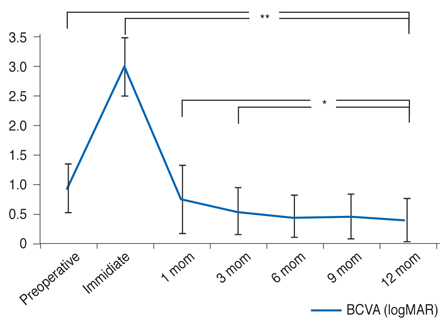Korean J Ophthalmol.
2018 Apr;32(2):140-146. 10.3341/kjo.2017.0085.
Visual Recovery after Macular Hole Surgery and Related Prognostic Factors
- Affiliations
-
- 1Department of Ophthalmology, Yonsei University Wonju College of Medicine, Wonju, Korea.
- 2Department of Ophthalmology, Institute of Vision Research, Severance Hospital, Yonsei University College of Medicine, Seoul, Korea. SEMEKIM@yuhs.ac
- 3Siloam Eye Hospital, Seoul, Korea.
- KMID: 2408954
- DOI: http://doi.org/10.3341/kjo.2017.0085
Abstract
- PURPOSE
To describe the visual recovery and prognostic factors after macular hole surgery.
METHODS
A retrospective chart review was conducted. Charts of patients with idiopathic macular holes who underwent surgery by a single surgeon at Severance Hospital between January 1, 2013 and July 31, 2015 were reviewed. The best-corrected visual acuity (BCVA) score was recorded preoperatively and at 1 day and 1, 3, 6, 9, and 12 months after surgery. The variables of age, sex, macular hole size, basal hole diameter, choroidal thickness, and axial length were also noted.
RESULTS
Twenty-six eyes of 26 patients were evaluated. Twenty-five patients (96.2%) showed successful macular hole closure after the primary operation. The BCVA stabilized 6 months postoperatively. A large basal hole diameter (p = 0.006) and thin choroid (p = 0.005) were related to poor visual outcomes. Poor preoperative BCVA (p < 0.001) and a thick choroid (p = 0.020) were associated with greater improvement in BCVA after surgery.
CONCLUSIONS
Visual acuity stabilized by 6 months after macular hole surgery. Choroidal thickness was a protective factor for final BCVA and visual improvement after the operation.
Keyword
MeSH Terms
Figure
Reference
-
1. Gaudric A, Haouchine B, Massin P, et al. Macular hole formation: new data provided by optical coherence tomography. Arch Ophthalmol. 1999; 117:744–751.2. Haritoglou C, Gandorfer A, Gass CA, et al. Indocyanine green-assisted peeling of the internal limiting membrane in macular hole surgery affects visual outcome: a clinicopathologic correlation. Am J Ophthalmol. 2002; 134:836–841.
Article3. Brooks HL Jr. Macular hole surgery with and without internal limiting membrane peeling. Ophthalmology. 2000; 107:1939–1948.
Article4. Vaziri K, Schwartz SG, Kishor KS, et al. Rates of reoperation and retinal detachment after macular hole surgery. Ophthalmology. 2016; 123:26–31.
Article5. Ullrich S, Haritoglou C, Gass C, et al. Macular hole size as a prognostic factor in macular hole surgery. Br J Ophthalmol. 2002; 86:390–393.
Article6. Sano M, Shimoda Y, Hashimoto H, Kishi S. Restored photoreceptor outer segment and visual recovery after macular hole closure. Am J Ophthalmol. 2009; 147:313–318.
Article7. Itoh Y, Inoue M, Rii T, et al. Correlation between length of foveal cone outer segment tips line defect and visual acuity after macular hole closure. Ophthalmology. 2012; 119:1438–1446.
Article8. Reibaldi M, Boscia F, Avitabile T, et al. Enhanced depth imaging optical coherence tomography of the choroid in idiopathic macular hole: a cross-sectional prospective study. Am J Ophthalmol. 2011; 151:112–117.
Article9. Zeng J, Li J, Liu R, et al. Choroidal thickness in both eyes of patients with unilateral idiopathic macular hole. Ophthalmology. 2012; 119:2328–2333.
Article10. Boonarpha N, Zheng Y, Stangos AN, et al. Standardization of choroidal thickness measurements using enhanced depth imaging optical coherence tomography. Int J Ophthalmol. 2015; 8:484–491.11. Kelly NE, Wendel RT. Vitreous surgery for idiopathic macular holes: results of a pilot study. Arch Ophthalmol. 1991; 109:654–659.12. Briand S, Chalifoux E, Tourville E, et al. Prospective randomized trial: outcomes of SF6 versus C3F8 in macular hole surgery. Can J Ophthalmol. 2015; 50:95–100.
Article13. Shinoda H, Shinoda K, Satofuka S, et al. Visual recovery after vitrectomy for macular hole using 25-gauge instruments. Acta Ophthalmol. 2008; 86:151–155.
Article14. Leonard RE 2nd, Smiddy WE, Flynn HW Jr, Feuer W. Long-term visual outcomes in patients with successful macular hole surgery. Ophthalmology. 1997; 104:1648–1652.
Article15. Purtskhvanidze K, Treumer F, Junge O, et al. The long-term course of functional and anatomical recovery after macular hole surgery. Invest Ophthalmol Vis Sci. 2013; 54:4882–4891.
Article16. Morgan CM, Schatz H. Involutional macular thinning: a pre-macular hole condition. Ophthalmology. 1986; 93:153–161.17. Allen RD, Brown J Jr, Zwick H, et al. Laser-induced macular holes demonstrate impaired choroidal perfusion. Retina. 2004; 24:92–97.
Article18. Aras C, Ocakoglu O, Akova N. Foveolar choroidal blood flow in idiopathic macular hole. Int Ophthalmol. 2004; 25:225–231.
Article19. Wei WB, Xu L, Jonas JB, et al. Subfoveal choroidal thickness: the Beijing Eye Study. Ophthalmology. 2013; 120:175–180.
Article20. Tan CS, Ouyang Y, Ruiz H, Sadda SR. Diurnal variation of choroidal thickness in normal, healthy subjects measured by spectral domain optical coherence tomography. Invest Ophthalmol Vis Sci. 2012; 53:261–266.
Article21. Chakraborty R, Read SA, Collins MJ. Diurnal variations in axial length, choroidal thickness, intraocular pressure, and ocular biometrics. Invest Ophthalmol Vis Sci. 2011; 52:5121–5129.
Article22. Sonoda S, Sakamoto T, Yamashita T, et al. Effect of intravitreal triamcinolone acetonide or bevacizumab on choroidal thickness in eyes with diabetic macular edema. Invest Ophthalmol Vis Sci. 2014; 55:3979–3985.
Article23. Vance SK, Imamura Y, Freund KB. The effects of sildenafil citrate on choroidal thickness as determined by enhanced depth imaging optical coherence tomography. Retina. 2011; 31:332–335.
Article24. Sogawa K, Nagaoka T, Takahashi A, et al. Relationship between choroidal thickness and choroidal circulation in healthy young subjects. Am J Ophthalmol. 2012; 153:1129–1132.
Article25. Landa G, Gentile RC, Garcia PM, et al. External limiting membrane and visual outcome in macular hole repair: spectral domain OCT analysis. Eye (Lond). 2012; 26:61–69.
Article
- Full Text Links
- Actions
-
Cited
- CITED
-
- Close
- Share
- Similar articles
-
- The Assessment of Fixation Area and Prognostic Factors in Idiopathic Macular Holes after Vitrectomy with Microperimetry Using Scanning Laser Ophthalmoscope
- The Evaluation of Prognostic Factors after Vitrectomy for Idiopathic Macular Hole with OCT
- Evaluation of Macular Hole Surgery using Confocal Laser Tomography
- Long-Term Visual Outcomes and Prognostic Factors for Successful Idiopathic Macular Hole
- The Evaluation of Prognostic Factors after Vitrectomy for Lamellar Macular Hole Using Optical Coherence Tomography




